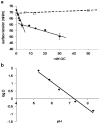Fabrication principles and their contribution to the superior in vivo therapeutic efficacy of nano-liposomes remote loaded with glucocorticoids
- PMID: 21998684
- PMCID: PMC3188566
- DOI: 10.1371/journal.pone.0025721
Fabrication principles and their contribution to the superior in vivo therapeutic efficacy of nano-liposomes remote loaded with glucocorticoids
Abstract
We report here the design, development and performance of a novel formulation of liposome- encapsulated glucocorticoids (GCs). A highly efficient (>90%) and stable GC encapsulation was obtained based on a transmembrane calcium acetate gradient driving the active accumulation of an amphipathic weak acid GC pro-drug into the intraliposome aqueous compartment, where it forms a GC-calcium precipitate. We demonstrate fabrication principles that derive from the physicochemical properties of the GC and the liposomal lipids, which play a crucial role in GC release rate and kinetics. These principles allow fabrication of formulations that exhibit either a fast, second-order (t(1/2) ~1 h), or a slow, zero-order release rate (t(1/2) ~ 50 h) kinetics. A high therapeutic efficacy was found in murine models of experimental autoimmune encephalomyelitis (EAE) and hematological malignancies.
Conflict of interest statement
Figures






Similar articles
-
Nano-Drugs Based on Nano Sterically Stabilized Liposomes for the Treatment of Inflammatory Neurodegenerative Diseases.PLoS One. 2015 Jul 6;10(7):e0130442. doi: 10.1371/journal.pone.0130442. eCollection 2015. PLoS One. 2015. PMID: 26147975 Free PMC article.
-
Amphipathic weak acid glucocorticoid prodrugs remote-loaded into sterically stabilized nanoliposomes evaluated in arthritic rats and in a Beagle dog: a novel approach to treating autoimmune arthritis.Arthritis Rheum. 2008 Jan;58(1):119-29. doi: 10.1002/art.23230. Arthritis Rheum. 2008. PMID: 18163482
-
Liposomal encapsulation of glucocorticoids alters their mode of action in the treatment of experimental autoimmune encephalomyelitis.J Immunol. 2011 Oct 15;187(8):4310-8. doi: 10.4049/jimmunol.1101604. Epub 2011 Sep 14. J Immunol. 2011. PMID: 21918186
-
Traditional concepts and future avenues of glucocorticoid action in experimental autoimmune encephalomyelitis and multiple sclerosis therapy.Crit Rev Immunol. 2009;29(3):255-73. doi: 10.1615/critrevimmunol.v29.i3.50. Crit Rev Immunol. 2009. PMID: 19538138 Review.
-
Glucocorticoids in multiple sclerosis and experimental autoimmune encephalomyelitis.Expert Rev Neurother. 2006 Nov;6(11):1657-70. doi: 10.1586/14737175.6.11.1657. Expert Rev Neurother. 2006. PMID: 17144780 Review.
Cited by
-
Nano-based approaches for the treatment of neuro-immunological disorders: a special emphasis on multiple sclerosis.Discov Nano. 2024 Oct 28;19(1):171. doi: 10.1186/s11671-024-04135-0. Discov Nano. 2024. PMID: 39466516 Free PMC article. Review.
-
Nano-Drugs Based on Nano Sterically Stabilized Liposomes for the Treatment of Inflammatory Neurodegenerative Diseases.PLoS One. 2015 Jul 6;10(7):e0130442. doi: 10.1371/journal.pone.0130442. eCollection 2015. PLoS One. 2015. PMID: 26147975 Free PMC article.
-
A Simple and Improved Active Loading Method to Efficiently Encapsulate Staurosporine into Lipid-Based Nanoparticles for Enhanced Therapy of Multidrug Resistant Cancer.Pharm Res. 2016 May;33(5):1104-14. doi: 10.1007/s11095-015-1854-4. Epub 2016 Jan 12. Pharm Res. 2016. PMID: 26758590
-
The Role of Glucocorticoids in Inflammatory Diseases.Cells. 2021 Oct 28;10(11):2921. doi: 10.3390/cells10112921. Cells. 2021. PMID: 34831143 Free PMC article. Review.
-
Drug Trafficking into Macrophages via the Endocytotic Receptor CD163.Membranes (Basel). 2015 Jun 23;5(2):228-52. doi: 10.3390/membranes5020228. Membranes (Basel). 2015. PMID: 26111002 Free PMC article. Review.
References
-
- Greenstein S, Ghias K, Krett NL, Rosen ST. Mechanisms of glucocorticoid-mediated apoptosis in hematological malignancies. Clin Cancer Res. 2002;8:1681–1694. - PubMed
-
- Schleimer RP, Spahn JD, Covar R, Szefler SJ. Glucocorticoids. In: Adkinson NF Jr, Yunginger WJ, Busse WW, Bochner SB, Holgate TS, et al., editors. Middleton's Allergy: Principles and Practice 6ed. Philadelphia: Mosby; 2003. pp. 870–913.
-
- Charmandari E, Kino T, Chrousos PG. Glucocorticoids. In: Yaffe JS, Aranda VJ, editors. Neonatal and Pediatric Pharmacology: Therapeutic Principles in Practice. Philadelphia: Lippincott Williams & Wilkins; 2010. pp. 760–772. 4 ed.
-
- Czock D, Keller F, Rasche FM, Haussler U. Pharmacokinetics and pharmacodynamics of systemically administered glucocorticoids. Clin Pharmacokinet. 2005;44:61–98. - PubMed
-
- Breimer DD. Future challenges for drug delivery. J Control Release. 1999;62:3–6. - PubMed
Publication types
MeSH terms
Substances
LinkOut - more resources
Full Text Sources
Other Literature Sources
Medical
Miscellaneous

